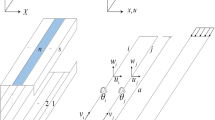Abstract
This paper demonstrates how to decompose general stability solutions into useful subclasses of buckling modes through formal definition of the mechanical assumptions that underlie a class of buckling modes. For example, a thin-walled lipped channel column as typically used in cold-formed steel can have its buckling mode response decomposed into local, distortional, global, and other (transverse shear and extension) modes. The solution is performed by writing a series of constraint equations that are consistent with the mechanical assumptions of a given buckling class. The mechanical assumptions that defined the buckling classes were determined so as to be consistent with those used in Generalized Beam Theory (see e.g., Silvestre and Camotim 2002a,b) The resulting constraint equations may be used to constrain the solution before analysis, and thereby provide the opportunity to perform significant model reduction, or may be employed after the analysis to identify the buckling classes that participate in a given buckling mode. This paper shows the framework for this process in the context of the finite strip method (building off of Ádány and Schafer 2004, 2005a,b) and discusses some of the interesting outcomes that result from the application of this approach. Of particular interest, and discussed here, is the definition of global buckling modes, and the treatment of members with rounded corners — each of which provide certain challenges with respect to traditional definitions of the buckling classes. Examples are provided to illustrate the technique and challenges. The long-term goal of the work is to implement the procedures in general purpose finite element codes and thus enable modal decomposition to become a widely available tool for analyzing thin-walled member cross-section stability.
Access this chapter
Tax calculation will be finalised at checkout
Purchases are for personal use only
Preview
Unable to display preview. Download preview PDF.
Similar content being viewed by others
References
Ádány, S., Schafer, B.W. (2004). ”Buckling mode classification of members with open thin-walled crosssections.“ Fourth Int'l Conf. on Coupled Instabilities in Metal StructuresRome, Italy27–29 Sept., 2004
Ádány, S., Schafer, B.W. (2005a). ”Buckling mode decomposition of single-branched open cross-section members via finite strip method: derivation.“ Elsevier, Thin-walled Structures, (Submitted)
Ádány, S., Schafer, B.W. (2005b). ”Buckling mode decomposition of single-branched open cross-section members via finite strip method: application and examples.“ Elsevier, Thin-walled Structures, (Submitted)
Cheung, Y.K., Tham, L.G. (1998). The Finite Strip Method. CRC Press.
Schafer, B.W. (1997). Cold-Formed Steel Behavior and Design: Analytical and Numerical Modeling of Elements and Members with Longitudinal Stiffeners. Ph.D. Disseration. Cornell University, Ithaca, NY.
Schafer, B.W., Ádány, S. (2005). ”Understanding and classifying local, distortional and global buckling in open thin-walled members.“ Tech. Session and Mtg., Structural Stability Research Council. Montreal, Canada.
Silvestre, N., Camotim, D. (2002a). ”First-order generalised beam theory for arbitrary orthotropic materials.“ Thin-Walled Structures, Elsevier, 40 (9) 755–789.
Silvestre, N., Camotim, D. (2002b). ”Second-order generalised beam theory for arbitrary orthotropic materials.“ Thin-Walled Structures, Elsevier, 40 (9) 791–820.
Author information
Authors and Affiliations
Editor information
Editors and Affiliations
Rights and permissions
Copyright information
© 2006 Springer
About this paper
Cite this paper
Schafer, B.W., Á;dány, S. (2006). Modal Decomposition For Thin-Walled Member Stability Using The Finite Strip Method. In: Pandey, M., Xie, WC., Xu, L. (eds) Advances in Engineering Structures, Mechanics & Construction. Solid Mechanics and Its Applications, vol 140. Springer, Dordrecht. https://doi.org/10.1007/1-4020-4891-2_34
Download citation
DOI: https://doi.org/10.1007/1-4020-4891-2_34
Publisher Name: Springer, Dordrecht
Print ISBN: 978-1-4020-4890-6
Online ISBN: 978-1-4020-4891-3
eBook Packages: EngineeringEngineering (R0)




